Cataracts are the leading cause of vision loss among adults 55 and older and are usually a result of aging. However, even young adults and children can have cataracts.
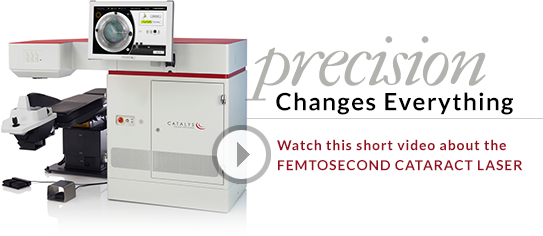
Cataracts can be best described as clouding of the eye’s natural lens, the part of the eye responsible for focusing light and producing clear, sharp images. Like all other living tissues in the body, old cells within the lens die and are continually replaced with new cells. Over time, the cells begin to block and diffuse light as it passes through the lens.
Cataracts are the leading cause of vision loss among adults 55 and older and are usually a result of aging. However, even young adults and children can have cataracts.
In the same way as the lens of a camera focuses light on the film inside, the eyes’ natural lens normally works to focus light on the retina along the inside back wall of the eye. Just as the dirty camera lens spoils an otherwise perfect picture, vision is impaired when the natural lens in the eye becomes clouded by cataracts.
Light cannot pass clearly to the retina, making the resulting image appear blurred or cloudy.
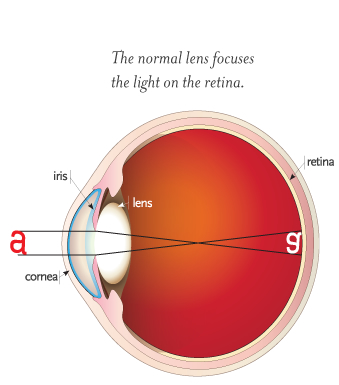
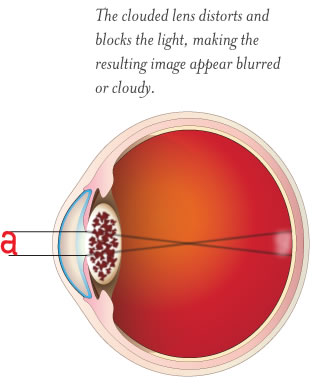
A CATARACT CAN TAKE MONTHS OR YEARS TO REACH THE POINT WHERE IT ADVERSELY AFFECTS VISION
-
How Cataracts Develop
The development of cataracts will vary from person to person, but generally they develop slowly over a period of time. A cataract can take months or years to reach the point where it adversely affects vision. However, one may develop a cataract rapidly as a result of a direct injury to the eye, in which a profound reduction of vision will then occur within weeks or months.
The effects of cataracts and the first signs of their development can also vary. Some patients notice a cataract as a reduction in central vision, while others may experience a problem in peripheral (side) vision. Still, others may notice a glare or a halo when looking toward light.
-
How Cataracts Affect Your Lifestyle
The most common symptoms of cataracts are blurred or fuzzy vision and sensitivity to light. These symptoms manifest as difficulty with driving (particularly at night), or otherwise restricting your ability to perform daily tasks of living. For example, cataracts can make reading difficult, especially small print.
Some people may notice that colors seem dull and appear less bright. Other patients experience difficulty when seeing objects up close (as in threading a needle or baiting a fishing hook). For others, trips, slips, falls, or other accidents may be the first indication that they have experienced a loss of vision.
-
Diagnosing Cataracts
Cataracts can be diagnosed only by a thorough eye examination. Trained and skilled in the eyes’ total health, your surgeon can determine whether a cataract or another eye disorder may be affecting your vision.
In an eye examination, the total health of your eyes, as well as the condition of your eyesight, is thoroughly examined. First and foremost, your visual acuity is checked to determine your current level of vision. Then a slit lamp is used to look inside your eye. Other testing devices may be used to determine the extent to which glare may be a detriment to your vision.
-
Your Options for Treatment
There is presently no medical treatment that will prevent cataracts or reverse them once they develop. The only treatment for cataracts is their surgical removal.
The decision to operate is reached by you and your surgeon together. This decision is based on the degree to which a cataract is impairing your vision and the effect this impairment has on your lifestyle.
If you opt for treatment there are several surgical treatments that may be used. Virtually all of these procedures are performed by removing the eye’s clouded natural lens and replacing it with an intraocular lens (IOL) implant.
THE LATEST ADVANCEMENTS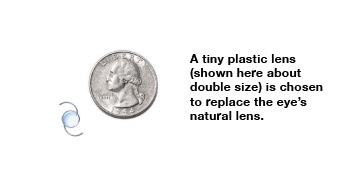
In the ever-evolving world of medicine, microincision surgery is the latest advancement for the treatment of cataracts. Designed to promote faster recovery of vision, microincision cataract surgery resulted from two developments in medical technology: phacoemulsification (the method of cataract removal) and the foldable lens implant.
To most patients, the potential benefits of microincision surgery include less discomfort during and after surgery, more rapid recovery, reduced risk of postoperative astigmatism (distorted vision) and swifter return to improved vision and normal activities. Also known as “no-stitch” surgery, microincision cataract surgery does not require the use of sutures.
THE DEVELOPMENT OF THE FOLDABLE LENS IMPLANT IS A BIG BREAKTHROUGH FOR MICROINCISION SURGERY
-
Phacoemulsification:
The First Step
The first step in microincision cataract surgery is a procedure called phacoemulsification. In phacoemulsification, ultrasound vibrations are used to break apart the cataract, fragmenting it into tiny pieces. The cataract is then removed using a suctioning device, leaving behind the intact back portion of the lens capsule. All of this is done through an incision approximately 2mm in size. Although phacoemulsifiation has been performed for several years, its full potential was not realized until the development of the foldable lens implant.
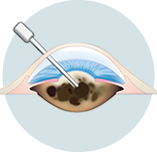
-
Foldable Lens Implants: Making Microincision Surgery Possible
The development of the foldable lens implant was a big breakthrough for microincision cataract surgery. These lens implants are made of soft, flexible material and have allowed the full benefit of phacoemulsification to be realized. Their soft construction enables the lens implant to be folded for insertion through the same microincision used during phacoemulsification. Once inside, the foldable lens implant is unfolded and set into place.
The foldable lens implant has been in general use since 1989. More than five million foldable lens implant operations have been performed since then.
THE BEST POSSIBLE VISION
Foldable lens implants allow for quick recovery of vision and in many cases enhance or improve the patient’s vision. With the sophistication of today’s technology, surgeons can often choose a particular power of a foldable lens implant following cataract removal to reduce a patient’s nearsightedness or farsightedness. This may result not only in restored sight, but also in improved distance vision without glasses following cataract surgery.
Eye surgeons have been able to treat the vision disorder known as astigmatism during cataract surgery. Astigmatism manifests as blurry vision both near and far; resulting from an irregularly shaped cornea. A brief procedure called astigmatic keratotomy (AK) can be performed to correct the irregularity. More recently, specific IOLs to correct astigmatism may be recommended. Toric ™ IOLs can reliably correct a large range of astigmatism and provide superior distance vision relative to the traditional IOLs. The combination of AK, Toric™ IOLs, and microincision cataract surgery can often provide better vision than many people have had at any point in their lives.
-
Multifocal Intraocular Lenses
The most recent development in intraocular lens design is multifocal lenses. These lenses are designed to provide excellent distance vision and functional vision for near tasks without the need for glasses. Ask your surgeon if this option is appropriate for you. The various IOL options will be discussed with you in detail during your evaluation.
ACCORDING TO A SURVEY CONDUCTED BY THE AMERICAN SOCIETY OF CATARACT AND REFRACTIVE SURGERY, VISION WAS SUCCESSFULLY IMPROVED IN MORE THAN 98% OF CATARACT PATIENTS.
AM I A CANDIDATE FOR MULTIFOCAL IOLS?
Once cataract surgery is recommended to improve your vision, your surgeon’s professional staff will spend the time necessary to review what typical daily activities are most important to you and help determine whether being independent of glasses for those activities is something that you would like to achieve. In order to achieve your goal of being able to see at far, intermediate (arms-length) and up close for reading vision, your surgeon may recommend one of the advanced intraocular lens technologies available today.
Each of these advanced technology implantable lenses uses a slightly different optical design to help you achieve your goal of clear vision at all distances. Your surgeon will discuss their recommendation based on the many factors obtained in your consultation.
Should you decide to have a multifocal lens implant, there will be additional fees that you will be responsible to pay. Medicare and most insurances cover the cost of the surgery, the surgical facility fee and the surgeon’s fee; however, they do not cover the cost of the multifocal lens and its implantation, the additional fees are the responsibility of the patient.
EACH OF THESE ADVANCED TECHNOLOGY IMPLANTABLE LENSES USES A SLIGHTLY DIFFERENT OPTICAL DESIGN TO HELP YOU ACHIEVE YOUR GOAL OF CLEAR VISION AT ALL DISTANCES.
COMMON QUESTIONS
How is a multifocal lens different from traditional monofocal intracular lenses?
Unlike traditional single-vision lens implants, a multifocal lens provides quality vision both at a distance and up close. Traditional single-vision lenses usually provide good vision only at a distance with limited ability to see objects that are near without glasses.
Will I still need to wear glasses if my surgeon recommends a multifocal lens?
The results will vary depending upon your vision, lifestyle and the anatomy of your eyes. Most people find that they need glasses to read small type or to drive at night. However, many others can go to the store or conduct their daily activities without depending upon glasses.
How long after surgery until I see my best?
Like most procedures, this depends upon the overall health of your eye. For most people, vision is noticeably better within a matter of days and continues to improve during the first few weeks after the procedure.
Does the multifocal lens require an adjustment period?
Yes. For most people there is a period of weeks when your brain is learning to “see” up close and at a distance with the new lens. This adjustment period is usually complete within 6 to 12 weeks but can take up to six months. Also, with all multifocal lenses, some people report halos or glare around lights. For most people this diminishes over time, while for others, it becomes less troublesome but never completely goes away. Most people report that the ability to see near and far without the distortions and glare caused by a cataract outweighs any visual side effects associated with the lens.
Are there any risks of having the multifocal lens procedure?
Yes. With any surgical procedure there are risks. The biggest risk with any cataract procedure is infection. Less than a quarter of one percent of patients having a lens implant procedure ever acquire an infection and most are treated successfully with medications. However, an infection left untreated can result in severe or total vision loss.


